|
Know anyone who
can benefit from this? Share!
|
|
|
   |
 Want more articles? Go
here
Want more articles? Go
here |
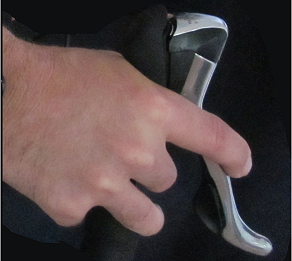
Why hands hurt?
A bike fitting guide
to resolving the most common issue in cycling
Hand pain and numbness is a recurring
subject of discussion among cyclists and the number one
complaint for cyclists seeking bike fitting services.
Hand pain is often accompanied by additional
complaints of lower back pain and shoulders/neck fatigue. Even
saddle discomfort and feet fatigue are often mentioned together
with hand pain.
Why is the issue of comfort at the hands
so common among cyclists? What's the source of this problem and
what can be done to resolve it?
In this article we'll answer these
important questions and attempt to demystify the myth that pain
is an unavoidable companion to bicycling.
THE SIGNS
Typical tell-tale markers of hands pain
and discomfort are shaking of the hands due to tingling, pins
and needles, numbness and excessive pressure - requiring frequent changes in hand
position on the handlebar. Stretching of the back while riding
is also a typical sign.
This is not a normal part of the cycling
experience and must be addressed to avoid further complications
that may require medical intervention for nerve damage.
THE SOURCE OF HANDS
PAIN
The source of hand pain is often
connected to a number of details in your bike fit and
your relationship to the bike. When linked together, these details can have a
compounding effect and work against your comfort and
even cause long-term issues.
Pain
is a manifestation of a biomechanical misalignment in
your current bike fit that
if often the result of a cascading series of events that
build upon each other.
Let's look at these events and
break them down to the basics:
- The position of the
saddle
- The position of the
handlebar
- The position of the
hoods, shifter pods and
brake levers
- The conditioning of the
core and upper body
THE SADDLE
The first culprit in your bike fit to be
linked to hand pain is the
saddle position.
Often misunderstood and overlooked by
inexperienced bike fitters, the saddle position has a very direct
relationship to hands pain. Frequently, the saddle position,
type and profile are responsible
for hands pain more than any other biomechanical
alignment parameter in your bike fit.
The saddle is the central point of contact
in your relationship with the bike. It helps stabilize your
pelvis and deliver power to the
pedals as the the main object of the bike fit position.
This is the core of a cyclist relationship to the bike and the
focal point of a cyclist's bike fit integration with the bicycle.
The saddle has many adjustments and a
proper bike fit should address all of them.
THE SADDLE TILT
The
tilt of the saddle - it's relationship to the horizon, whether
pointing up or down - is a key detail in your bike fit.
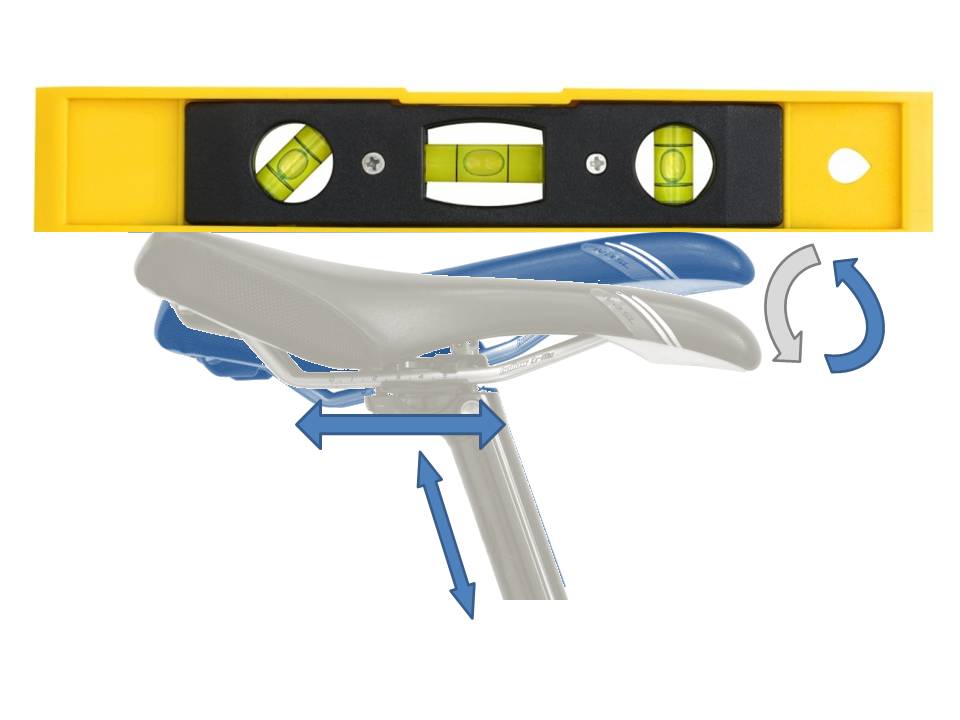 Too much nose down and
the weight of the upper body is pushed into the hands. The arms
lock up in this position and all the terrain vibrations transfer
to the hands, causing excessive pressure and pain that can climb
all the way to the elbows and shoulders. Eventually, this can
also lead to lower back pain.
Too much nose down and
the weight of the upper body is pushed into the hands. The arms
lock up in this position and all the terrain vibrations transfer
to the hands, causing excessive pressure and pain that can climb
all the way to the elbows and shoulders. Eventually, this can
also lead to lower back pain.
Too much tilt up of the saddle
also causes excessive hand pressure, but through a more
complicated mechanism: the backward rotation of the hips. This
counter rotation of your pelvis disengages your core and the
support it provides to the upper body, thus putting more weight
on the hands.
If you see a cyclist looking shaped like a
"C", you can bet that's an issue with hip rotation and saddle
tilt in the bike fit.
There is a sweet spot for saddle tilt.
It's not universal and varies among manufacturers.
Saddles designed for aero bikes (road or
triathlon) have a design point tilt: a specific nose down
angle that keeps the pressure off the genitals when in a low
body posture without putting too much pressure on the hands. The
bike fit must set you up according to this design point.
Saddles made for mountain bikes tend to
offer a wider sweet spot in a more level position. Your mountain
bike fit should be aligned with a less saddle nose down tilt.
Finding hands pressure relief in your bike
fit through tuning the saddle tilt works only if the saddle
itself is right for you.
The saddle profile plays a major role in
the bike fit and the potential for hands pressure and pain.
If the configuration of the saddle does
not match closely the profile of your ischial bones,
there will be pressure points in your butt, groins and genital
area.
Hands pressure comes from the instinctive
action of a cyclist attempting to reduce pain in the seat
bones by supporting with his/her arms.
The wrong saddle profile also tends to bring discomfort not only at the hands but at the feet as well.
This is very occult phenomenon understood only by a handful of
bike fitting individuals. The wrong saddle profile creates
neural path impingements that can transfer to the feet.
It's a complex issue that exceeds the scope of this article. But
it wouldn't be complete without at least mentioning the
occurrence.
It becomes therefore paramount that,
during a bike fit, the
saddle model chosen by a cyclist is based on effective
comfort - not weight savings or looks. And this is the reason
why many manufacturers like Selle SMP have test programs with
the best bike fitters where a
saddle can be fitted and loaned to be experienced for a few rides.
THE SADDLE FORWARD AND AFT POSITION
The saddle forward and aft position plays an intimate dance with
the next item in the list: the handlebar.
The saddle can be adjusted to move its position
relative to the cranks. During the bike fit, this determines the power output.
This position is highly dependent on the type of bike and the
basic tenet of bike fitting.
The
position of the handlebar takes on a supportive and complementary
role to the forward and aft position of the saddle.
The relationship of the saddle to the
handlebar is the very important for comfort. If the saddle is
too close to the handlebar, the weight of your upper body is
forced upon the shoulders. The shoulders in turn lock the arms
and the hands receive all the terrain chatter.
Similarly, when
the saddle is too far away from the handlebar, the back is too
stretched out to reach the controls and the arms become locked
out in the overextension. This also causes the hands to take all
the abuse from the terrain feedback.
Let's look at the next item in the list: the
handlebar.
THE HANDLEBAR
The position of the handlebar with respect
to the saddle is very important in the bike fitting quest to
resolve hands pressure.

An integrated handlebar/stem combo like this, saves on
aero drag, but it cannot be adjusted during the bike fit and
can affect the proper reach |
The location of the handlebar on
your bike fixes the hands point of
contact and determines the overall reach - together with the
saddle forward and aft position. It also can affect the handling characteristics of the bike.
A handlebar that's too far away from you
causes hands distress and excessive pressure.
When the reach is too long, the
arms become completely straight and the elbows lock out.
A healthy elbow bend is a basic goal for bike fitting as
this bend acts as a shock absorber. When the elbows are
locked out, all the pressure transfers to the hands.
Also, when the handlebar reach is
too short and the bars are too close to you, hands take
a beating. This is due to the fact that all the weight
of your upper body is on the shoulders and get
transferred to the hands.
During a proper bike fitting
session, the stem is routinely replaced to align your
handlebar reach to your saddle position so the upper
body can perform its supporting role.
|
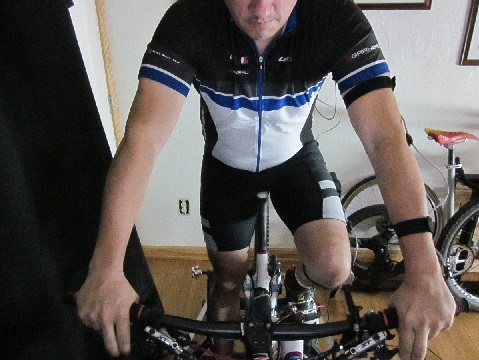
The handlebar sweep set up for mountain biking is a
critical part of a bike fit that will prevent hands pain
|
For mountain bikers the handlebar set up
gets a little more complicated because of the sweep.
Sweep is the curvature built into mountain
bike handlebars to reflect the fact that human shoulders operate
in circular fashion when sweeping through the range of motion.
Human arms essentially move like the radius
of a circle across the width of the shoulders range of motion.
So handlebars are built to mimic this motion with a clever
design so that the sweep can be increased or decreased with a
simple twist of the bars on the stem.
There are 2 types of sweep built in most
bars: back sweep (the horizontal turn radius of the shoulder)
and up sweep (the vertical).
When set up incorrectly, the sweep of the
bar plays havoc with the relationship of the wrists to the bar.
Too much sweep forces the wrists into an unnatural rotation that
puts tremendous pressure on the hand's ulna (the bone at the
external edge of the palm and the wrist) and the underlying ulnar
nerve.
Pressure on this nerve creates the same
issues as we discussed above for road cyclists: numbness in the
hands, tingling and even tennis elbow.
For mountain bikers this is a crucial part
of the bike fit that often goes ignored by many bike fitters.
|
The handlebar position is also intimately
connected with the position of the hoods, shifter pods and
brakes: the flight controls, next on our list.
FLIGHT CONTROLS
The last piece of the bike fitting quest
to reduce hands pressure is the
relationship with the "flight controls": the shifter
hoods for road bikes and the grips, shifter pods and brake
levers for mountain bikes.
Often overlooked by inexperienced bike
fitters, the position of flight
controls is critical in achieving the "ergonomic design point"
of components designed for a specific use.
Bicycle and ergonomics are not something
we are used to hearing. But not
only bicycle ergonomics exist; in the last ten years, the
cycling industry as made a huge effort in this area, pouring
into R&D and improving the comfort of riders with
ever-sophisticated products.
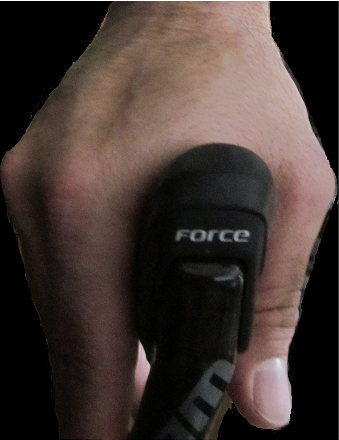 Modern brake/shifter hoods are designed with your hand and grip
in mind. |
The sophistication of the ergonomics also
means that they need to be aligned correctly during a bike fit or they will work
against your comfort.
For road cyclists, modern shifter hoods are
such a finely tunable piece of equipment that are a bliss to ride
-when aligned correctly.
The transition between the handlebar and the
hood is one key component in hands comfort.
Often, this transition is overlooked or
downright set up wrong during the initial bike build and never
improved.
If you experience your fingers tingling or going
to sleep and all other items we discussed above are in check,
then your shifter hoods ergonomics are out of alignment. |
|
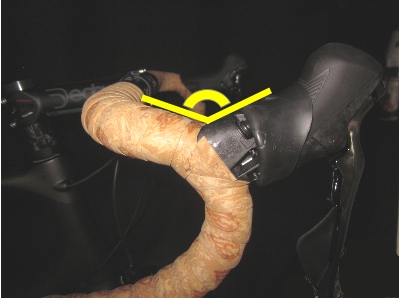
The transition between the bar tops and the shifter hood in this
picture is incorrect |
The "pins and needles" and hands pain
in this case are caused by the lack of blood circulation and/or
the depression of the a critical nerve in the palm of the hand,
near the wrist on the pinkie finger side: the ulnar nerve.
The ulnar nerve -and blood vessels that run
collocated to it- are responsible for a variety of functions in
the hands. When consistently put under stress by applying
excessive pressure, the nerve responds with the sensation of
shooting pains that make fingers "go to sleep".
This sensation can
climb to the elbow and give the same feeling as "tennis elbow".
From a safety perspective, this can be a hazard as this
situation can severely reduce the ability to squeeze the brake
levers adequately enough for a sudden stop.
A similar consideration goes for carpal
nerves. Most people are familiar with these nerves because of
the notoriety of stress caused by computer keyboards and the
resulting carpal tunnel syndrome. Most cyclists use
computers in their daily lives and the effect of poor flight
controls ergonomics compound on those of of their daily professional
instruments. |
This is part of bike fitting that often
completely forgotten by many bike fitters. Not a second thought
is given to the ergonomics of the bike fit. When flight
controls are overlooked, even a good bike fit alignment to the saddle
and handlebar will fail the test of hands comfort.
A proper bike fitter will spend onsiderable time working with hood-to-handlebar transition
alignment, taping of the handlebars at the bar tops, brake lever reach (not only for mountain bikes, today
components like SRAM offer this option on road bikes as well),
shifter pods, suspension lock-out and dropper post alignment.
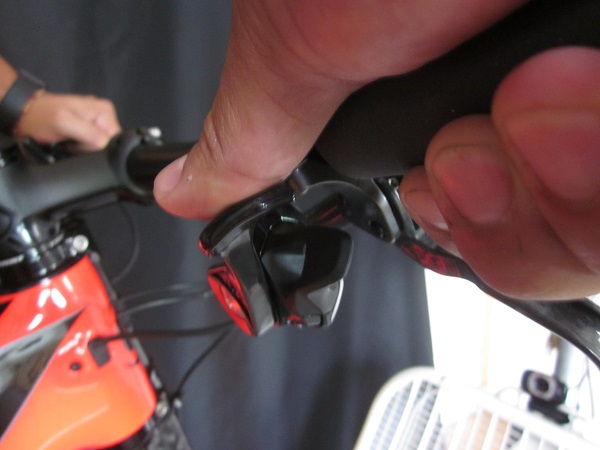
A well aligned cockpit prevents strains
of the
hands |
For mountain bikers, there are
even more adjustments and nuances that go into the
ergonomics of the flight controls.
We mentioned the very critical handlebar sweep as it relates to wrist
alignment and ulnar pressure.
But just as critical are the brake
levers position, the lever reach, the shifter pods
alignment and the grips..
The thickness and compliance of
the grips is often an overlooked culprit of hand pain.
Worn out grips have lost their ability to isolate the
hands from the handlebar and can result in a variety of
comfort issues spanning from fatigue to severe pain. The
same goes for very thin grips.
The size of the grip is important.
Not all grips have the same diameter. Some are larger
and thicker, some are just larger (lock on) and some are
thin by design - and everything in between. This is very
important for women who need to carefully choose grip size
to match their smaller hands.
|
|
Grips have specific applications.
Cross country and trail grips tend to provide more
cushion. Downhill and BMX grips tend to be thin and
designed for the death grip required for short, intense periods of riding. Selecting the right
grip may go a long way to improve comfort.
However, caution must be taken
when attempting to mask a bad bike fit and
neutralize hand pain with "ergonomic grips".
We
have seen some severe cases where the pain subsided just
enough with ergo grips to make is acceptable to the
cyclist. However, the nerve damage grew over time to the
point of requiring medical attention. Grips should be
considered as part of a comprehensive approach to bike
comfort and bike fitting - not in isolation.
The location and functionality of the brake
levers has a similar effect as the bar sweep in the critical
alignment of the wrist and the resulting pressure on the ulnar
nerve. We often see brake levers positioned such that require
extreme wrist rotation to activate.
Over time, brake levers that require
straining to operate are going to cause repetitive use injuries,
so great care must be taken in working with the lever reach alignment to prevent
this issue.
|
AT THE CORE
We saved this for last because it's not
something that a bike fit can fix during a session.
Most cyclists tend
to neglect their core and upper body. And it's up to you to fix
this.
A good bike fitter should know to test and
point out if your core needs conditioning and if it's affecting
your relationship to the bike.
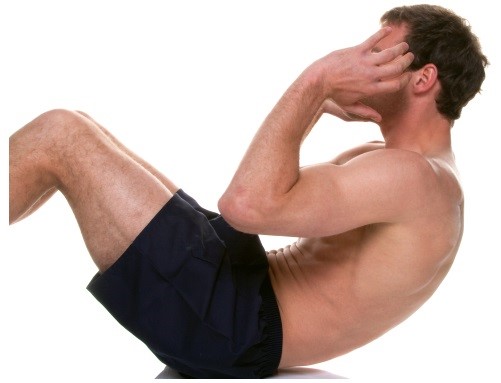 The core is the opposite side of the token
as the saddle. The saddle is the physical point of
leverage between the upper and lower body; the core is the
physiological fulcrum.
The core is the opposite side of the token
as the saddle. The saddle is the physical point of
leverage between the upper and lower body; the core is the
physiological fulcrum.
When the core is weak, there is
instability between the lower body generating power and the
upper body trying to direct it. This causes the lower back to
destabilize.
To control it, a cyclist locks the arms. This
in turn puts a tremendous pressure on the hands as they take the
abuse from the thrashing generated by pedaling power and the
terrain chatter.
After a few miles of this tug of war,
the core exhausts its resources - and so the upper
body. This causes the hands go to sleep and the lower back to ache as
it starts curving up.
Without a proper foundation in the core,
even the fittest of cyclists experience varying level of
discomfort. The core supports the upper body and takes pressure
off the hands.
The shoulders and arms play an important
role also. A stronger upper body together with a strong core
enables a cyclist to bend the elbows while riding. This flexion
creates a suspension mechanism that takes pressure off the
hands, shoulders and neck. The core provides some of the
stability needed to support the torso and does so while
generating power for the legs to do their business.
At parity of a good fit, cyclists
with a strong core are going to outperform - and are
significantly more comfortable.
Care must be taken when developing the
core, however. Abs are not a significant part of the core. They
are a veneer.
When developing core strength, the pelvic
and dorsal muscle groups must be developed symmetrically, or
issues with comfort may continue to dodge a cyclist.
Specific core exercises are outside the
scope of this article. However, there's plenty of uTube videos
that show core strengthening exercises for cyclists.
CONCLUSIONS
Hand pain is unfortunately a common issue
facing many cyclists today. But it does not have to be a
constant companion.
Hand pain comes from the complex interaction
between a variety of factors in your bike fitting and
ergonomics. No one factor plays such a larger significant role
that a single course of action can be recommended. There is no
magic wand that can be waved and caution must be paid to avoid
buying into the hype of products that claim to cure hand pain -
in particular ergonomic grips, handlebar gel wrap tape and
gloves with generous amounts of padding.
Instead, hands pain must be addressed as a
comprehensive approach to bike fitting and ergonomics, tending
to each of the main culprits: handlebar position; saddle position; flight control
ergonomics; core and upper body strength.
With proper bike fitting, knowledge of
ergonomics and
attention to details, hand pain can be removed from the riding experience.
Our bike fitting studio developed a set of
specific bike fitting protocols designed to address comfort,
pain and recovery from injuries.
We named these protocols "Bike Fitting for
Injuries" and they are engineered to address a variety of
comfort-specific issues while achieving all the typical goals of
a bike fit - more power, better handling and faster speeds.
If you are experiencing hand pain, numbness
and/or tingling don't delay getting a professional bike fit. We
can help.
A Perfect Bike Fit Pro Studio
Love your ride. Get a bike fit.